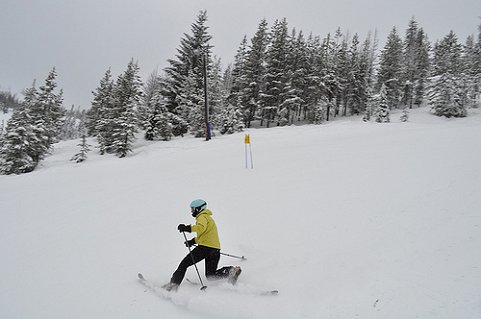
Telemark skiing. The Quest for perfect, untouched snow.
Photo Courtesy of Jarlybart's Photostream
Nope, Telemark skiing is not a skier making annoying calls to you while he enjoys himself on the slopes. It’s actually the name of a very serious skiing sport.
So what is Telemark skiing anyway?
The name Telemark is derived from the Telemark area of Norway. Back in around 1868 a skier named Sondre Norheim was quite a famous athlete. In fact he was so famous this sculpture of him stands today in Morgedal
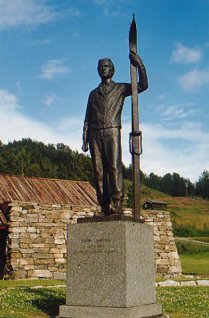 He was a fantastic daredevil on skis. He was a wonderful woodworker and furniture maker and he built his own skis. In fact he built skis for people from all over Norway.
He was a fantastic daredevil on skis. He was a wonderful woodworker and furniture maker and he built his own skis. In fact he built skis for people from all over Norway.
Although skiing had been done for hundreds of years previously, it was mainly a manner to go across deep snow without sinking to a persons hips. Sondre made skiing fun. He would ski off of any hill or rooftop he could find. He invented the Telemark turn because he couldn’t figure out how to turn with the skis parallel. If you look at his skis here you will not the total lack of what we call a binding today. All he had was this little braided binding made of rawhide. You can only imagine what it was like trying to turn with this to hold your ski on to your foot.
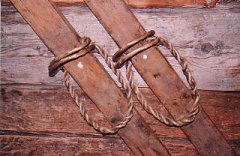 Sondre's Skis
Sondre's Skis
Eventually a new turn called the was perfected and introduced in around 1910 and replaced the Telemark which was more suited to very steep terrain such as that seen here. The Stem Christiania was named for the city of Christiania (now called Oslo), Norway.
Sondre and his skiing partners also perfected parallel skiing thus laying the foundation of modern skiing as we know it today.
From the 1910s onward until after WW2 Telemark skiing declined in popularity, but it has had it’s revival in the 1970s in the United States as a back to basics reaction to the ever changing ski industry. Some purists wanted to get back to the traditional methods and even go so far as to dress in the traditional garb of the early skiers.
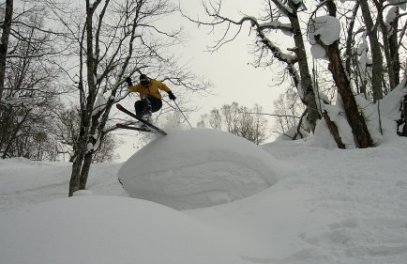
The telemark revival had it’s beginnings in Crested Butte, Colorado, and quickly became popular in many other areas especially the Western states. In Italy at the Interski facility in 1983 a demonstration team from the Professional Ski Instructors of America caught the attention of a large public gathering. Although it remains a minority sport is still has a good following.
Equipment
Telemark skiing utilizes equipment similar to alpine skis. In fact many advocates use alpine skis in their endeavors. However some manufacturers produce lighter and wider skis for telemark skiing. They build in a little more flex than alpine skis.
Boots
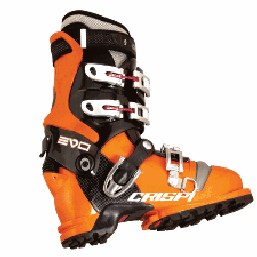 Durable polymer has slowly replaced leather boots. They feature a bellows above the toes to allow greater flexibility required for making the telemark turns. All standard telemark boots feature a trapezoidal duckbill at the front with three pinholes on the bottom for attaching the boot to the binding. Each year the boot manufacturers have been introducing stiffer boots with additional buckles. Note the raised heel.
Durable polymer has slowly replaced leather boots. They feature a bellows above the toes to allow greater flexibility required for making the telemark turns. All standard telemark boots feature a trapezoidal duckbill at the front with three pinholes on the bottom for attaching the boot to the binding. Each year the boot manufacturers have been introducing stiffer boots with additional buckles. Note the raised heel.
Bindings
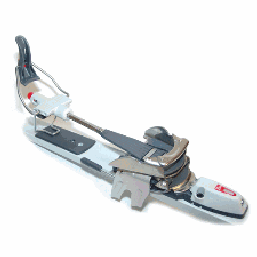 The bindings are what hold the boot to the ski. The earlier versions featured the three pin binding whereby the boot had matching pin holes in the duckbill and a clamp on the binding fastened the toe in place.
The bindings are what hold the boot to the ski. The earlier versions featured the three pin binding whereby the boot had matching pin holes in the duckbill and a clamp on the binding fastened the toe in place.
The cable bindings came next and featured a spring loaded cable to hold the boot in place. They also had the socket to secure the duckbill but they didn’t have the pins. The spring loaded cable was stretched around the back of the boot and fitted into a groove in the heel. They were cumbersome to use.
Hinged plate bindings combine the lateral stiffness of the alpine binding with the flexibility of the telemark binding.
Telemark equipment manufacturers have followed the trend of newer and better designs, adding more performance possibility into the bindings.
Climbing Skins
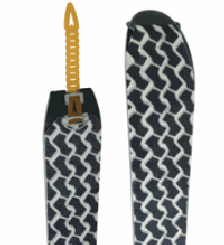
Anyone who has ever tried cross country skiing will attest to the fact that climbing uphill is a bother. With the introduction of the fish scale skis the problem has been eased somewhat but the trade off is a slower ski. Waxing the waxable ski was a problem as the temperature changes while ascending the hill had to be accounted for.
Mohair was found to be excellent for climbing with skis. A strip added to the underside would keep the ski from slipping backward. Therefore they were called skins. Then synthetic material that copied mohair was introduced and these became popular. They are clipped to the front tip of the ski and attached to the back tail. Once the hill is conquered the skins are removed and away you go. Harscheisen
Telemark Skiing accessories must include some kind of apparatus for getting down icy slopes. If not you may be in for a long slide down a steep slope on your rear end. Harscheisen are ski crampons or coteau or cortelli are just the item that may save you from that journey.
The edges used in the Telemark skiing turn are the same as used with a parallel turn, except that a Telemark turn involves leading into the turn with the outside ski as you trail the inside ski. To begin the turn you edge the outside ski with a flat heel and simultaneously lift the heel on the inside ski to shift the ski back to the Telemark stance. Through the turn, your weight is shifted onto the outside ski, and is primarily onto the toes even though the outside heel is flat on the ski.
One part of the turn that takes more experience to get right is to place enough weight on the trailing ski to get it to carve the turn. Most often, while gaining that experience, you may want to keep a little more weight on the inside ski to help with the turn, using the outside ski as a buffer to control the cut through the snow and to keep the ski tip up above the powder.
Stagger
There is no question that the Telemark skiing technique means staggered skis in the turn, not everyone agrees on how much they should be staggered. If you watch ten people do the turns, you are apt to see ten different levels of the bodies. Some skiers will almost have the trailing ski knee almost touching the ski and others will be quite erect with very little knee bend.
As a general rule, the trailing knee should bend to a horizontal position and there should be a boots length between the outside and inside feet. If you learn to do the turn with your inside knee too low you will get away with it until you hit into some icy snow where you may have contact with the knee and ice and hurt yourself.
Experienced Telemark skiers look for the balanced position over their skis, as do alpine skiers, with their bodies oriented downhill while doing their turns. This position really helps with weight distribution control.
While skiing in thick powder it is important to stay forward and not lean back as this allows for better control and you will be able to respond quickly to the changing conditions. Since your heels are not fixed to the ski, it is easy to pitch forward head over heels if you hit a heavy or icy mass. If you Keep your weight balanced and centered over your skis you will be able to handle the tough stuff. Be sure to always keep your hands ahead of your body.
Poles are optional in Telemark skiing. Some will never part with them. Others will use one long one called a lurk which is held in both hands in the style used many years ago. It may be used either on the inside or outside of the turn.
Face shots
One sensation Telemark skiers love over alpine skiers is the ability to get a face full of powder this “face shots.” The alpine skier simply cannot get a face shot on the groomed trails.
Tour the Mountain. Look at all the skiing Whistler/Balckcomb has waiting for you.
Discover Scotland
A warm welcome awaits you, whether you choose to explore the diverse Culture and Traditions, or experience the magic with an action packed programme of Outdoor Activities and Events.
Turks & Caicos Beach Vacation Guide
Travel to the tropical Caribbean paradise of the Turks & Caicos Islands. Get insider tips on the best beaches, resorts, villas, real estate, restaurants, fishing, diving, activities, sights and sounds you’ll experience when visiting this enchanting oasis.
Return from Telemark Skiing to Whistler Outdoors



